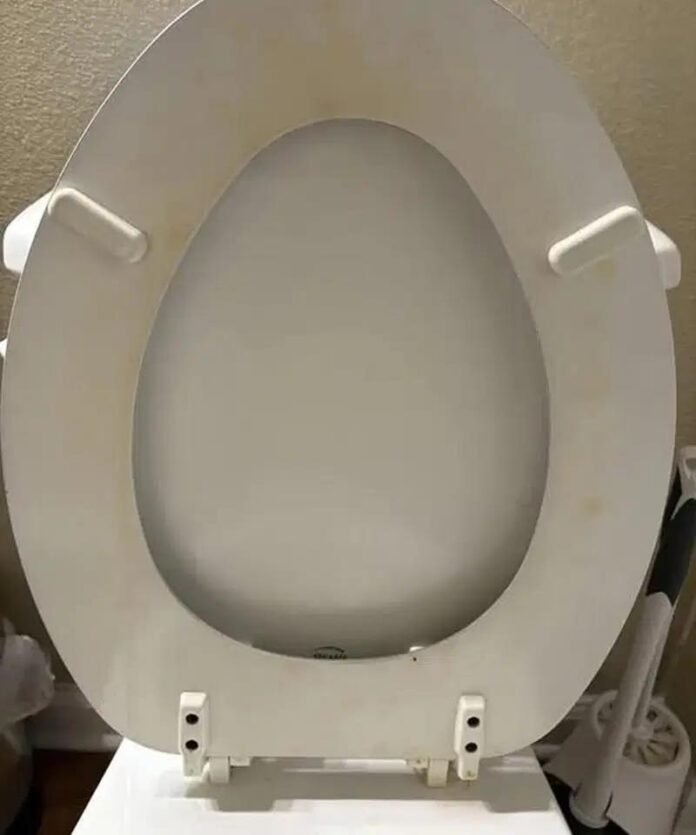Let’s face it — no matter how clean the rest of your bathroom is, that ugly yellow ring on the toilet seat has a way of stealing the spotlight.
For the longest time, I tried to ignore it. I’d give it a half-hearted wipe here and there, maybe hope the lighting would hide it when guests came by. But all it took was one brutally honest comment — “Oh, what happened to your toilet seat?” — to snap me into action.
I wasn’t ready to buy a brand-new seat just yet, so I rolled up my sleeves and went on a mission to learn how to clean a yellow toilet seat using simple, safe, and budget-friendly methods. I found some surprising DIY solutions that didn’t just cover the stains — they removed them.
Turns out, with the right tricks and a little elbow grease, your bathroom can sparkle again — no expensive replacements needed.
The Ultimate DIY Combo: Baking Soda and Vinegar
I started with something I already had in the kitchen: baking soda and white vinegar. This isn’t just an old wives’ tale — this combo really works. Together, they form a powerful, natural reaction that breaks down grime, stains, and even the dreaded yellow discoloration on plastic toilet seats.
Here’s what I did:
I mixed the baking soda and vinegar into a thick paste. Not too watery, not too dry — think cake frosting consistency. I spread it over the stained parts of the toilet seat and let it sit there for about 15 minutes.
Then I grabbed an old toothbrush (no need for anything fancy) and gave it a good scrub. I wasn’t expecting much, but I was shocked. Years of grime and build-up started lifting off almost instantly.
There were still a few stubborn spots that didn’t want to budge — but I had a backup plan.
Magic Eraser to the Rescue
If you’ve never tried a Magic Eraser before, now’s the time. It’s one of those tools that lives up to the hype.
After my baking soda scrub, I dampened a Magic Eraser and went over the remaining stains. And just like that, the last traces of yellow disappeared. It was honestly a little embarrassing how easy it turned out to be after all those months of ignoring it.
These erasers work wonders on hard plastic surfaces, which makes them ideal for toilet seats. They don’t require any harsh chemicals either, which is a big plus if you have sensitive skin or prefer non-toxic cleaning products.
For Deep Stains: Hydrogen Peroxide Works Wonders
Sometimes, those yellow stains go deeper than the surface. Maybe it’s from hard water, or maybe just years of use. If the baking soda and Magic Eraser don’t do the trick, hydrogen peroxide might be your best bet.
Here’s the method that worked for me:
- I soaked several paper towels in hydrogen peroxide.
- Then I layered them over the stained areas.
- I left them there for an hour (no scrubbing needed).
When I lifted them off, the stains had faded dramatically. A few more minutes of wiping, and it looked like a brand-new seat. The best part? It didn’t damage the plastic at all.
Important safety note: Never mix hydrogen peroxide with vinegar — the combination can create harmful fumes. Use each method separately, with plenty of ventilation.
Don’t Forget the Toilet Bowl
Once I’d tackled the seat, I realized the inside of the bowl needed some love too. Those dark mineral rings and calcium stains around the waterline weren’t going to disappear on their own.
That’s when I turned to a pumice stone and Borax powder.
At night, I sprinkled Borax into the bowl and let it sit while I slept. The next morning, I gently scrubbed the tough spots with a wet pumice stone. It’s important to keep the stone and bowl wet to avoid scratching.
And just like that — the mineral stains were gone. It was like hitting reset on a decades-old toilet.
Sunday Cleaning Routine That Actually Feels Good
Now that I’ve got my system down, I’ve added bathroom cleaning to my Sunday routine. I know it’s not the most glamorous chore, but there’s something incredibly satisfying about walking into a spotless bathroom — especially when you’ve cleaned it with your own two hands.
It’s not just about impressing visitors. For me, it’s about reclaiming that sense of control and pride in my home, even if the laundry isn’t done and there are dishes in the sink.
A clean toilet, it turns out, goes a long way.
Bonus Tips for a Fresher Bathroom
Want to take things a step further? Here are a few extra tips that make a noticeable difference:
- Smelly toilet brush? Soak it in a cup of hydrogen peroxide for 30 minutes. It’ll kill the bacteria and leave it smelling fresh.
- Dirty hinges on the toilet seat? Use a cotton swab and a bit of vinegar to get into the crevices.
- Grimy base of the toilet? Don’t forget to wipe it down weekly — it’s where most odors hide.
- Tile floor around the toilet? A quick mop with warm water and dish soap can freshen it up in minutes.
These little touches add up, especially in small spaces like a bathroom. You don’t need fancy gadgets or pricey cleaners — just a few basics, a little patience, and the motivation to take care of your space.
Why It’s Worth It
Cleaning your bathroom isn’t just a chore — it’s a small act of care for yourself and your home. Especially as we get older, keeping things fresh, tidy, and functional becomes more important. Not only does it make your home more inviting, but it can also help reduce bacteria, allergens, and even fall risks from slippery floors.
I used to avoid deep cleaning the bathroom because it felt overwhelming. But now that I’ve found these simple, effective methods — from baking soda and vinegar to hydrogen peroxide and Borax — I actually look forward to the ritual. It’s become a kind of quiet therapy. Just me, a toothbrush, and the satisfaction of a sparkling clean toilet seat.
So if you’ve been avoiding that yellow stain, don’t feel bad — but don’t wait any longer either. You’ve got all the tools you need right at home.
And trust me, the next time someone uses your bathroom and doesn’t say a word? That silence will feel like a standing ovation.



